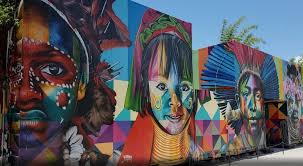
The Influence of Street Art on Contemporary Visual Culture
Street art, once considered a form of vandalism, has evolved into a respected and influential art form that has significantly impacted contemporary visual culture. From its roots in graffiti and urban subcultures, street art has grown to encompass a wide range of styles and techniques, becoming a powerful medium for social commentary and artistic expression.
The rise of street art can be traced back to the 1970s and 1980s, particularly in cities like New York and Philadelphia. What began as tags and throw-ups on subway cars and building walls gradually evolved into more complex murals and installations. Artists like Keith Haring and Jean-Michel Basquiat helped bridge the gap between street art and the traditional art world, paving the way for future generations of street artists.
One of the most significant contributions of street art to contemporary visual culture is its democratization of art. By taking art out of galleries and museums and placing it in public spaces, street artists have made art accessible to a wider audience. This has challenged traditional notions of who can create art and who it's for, fostering a more inclusive art world.
Street art has also been a powerful tool for social and political commentary. Artists like Banksy have used their work to criticize war, capitalism, and social injustice, often with a dose of humor and irony. The ephemeral nature of street art allows artists to respond quickly to current events, making it a dynamic and relevant form of expression.
The aesthetic of street art has had a profound influence on graphic design, fashion, and advertising. The bold colors, graphic styles, and urban imagery associated with street art have been adopted by mainstream brands looking to appeal to younger, more urban demographics. This has led to collaborations between street artists and major companies, further blurring the lines between subculture and mainstream culture.
The digital age has transformed the way street art is created, shared, and experienced. Social media platforms have allowed street artists to document their work and share it with a global audience, giving ephemeral pieces a form of permanence. This has also led to the phenomenon of "Instagram walls," where businesses commission murals specifically designed to be shared on social media.
Cities around the world have begun to recognize the cultural and economic value of street art. Many now have dedicated areas for legal street art and even sponsor mural festivals. This official recognition has led to debates within the street art community about authenticity and the potential loss of the art form's rebellious spirit.
The influence of street art can also be seen in the fine art world. Many street artists have successfully transitioned to gallery shows and museum exhibitions. The 2018 auction of Banksy's "Girl with Balloon," which partially shredded itself after being sold, was a pivotal moment that highlighted the complex relationship between street art, the art market, and performance.
Education has also been impacted by the rise of street art. Many art schools now offer courses in street art techniques and history, recognizing its importance in contemporary art. Community organizations often use street art projects as a way to engage youth and revitalize neighborhoods, showcasing the social impact of this art form.
As we look to the future, street art continues to evolve. New technologies like augmented reality are being incorporated into street art, creating interactive experiences. The ongoing dialogue between street art, contemporary art, and popular culture ensures that this dynamic art form will continue to shape our visual landscape and challenge our perceptions of what art can be and where it belongs.